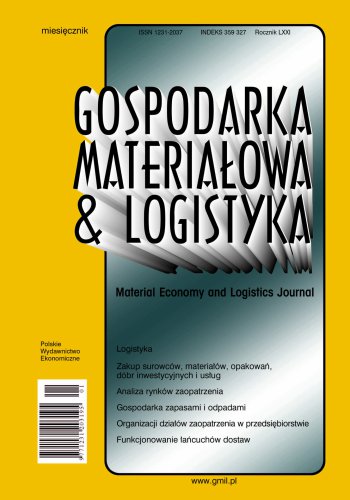The impact of the COVID-19 pandemic on the implementation of consumer returns
Adapting the return policy to the changing market situation became particularly important challenge during the COVID-19 pandemic. A well-developed and liberal return policy was a determinant of the overall level of service offered by the company for consumers and contributed to increasing customer loyalty. While there is a great deal of research available that looks at characteristics of e-commerce in general, relatively there is little known about the extent of consumer returns, particularly in relation to the current impact of the COVID- 19 pandemic. However, such data is necessary for a number of reasons. For example, to better prepare the pricing policy or to calculate the profitability of a selected e-commerce business model. The aim of the article is to present the changes taking place in the consumer return policy both in stationary and online transactions during the COVID-19 pandemic. The consumer regulations of various retail stores, from the fashion industry, will be analyzed.
References
Bibliografia/References
Baiman, S.; Fischer, P. E.; & Rajan, M. V. (2000). Information, contracting, and quality costs. Management Science, 46(6), 776–789. https://doi.org/10.1287/mnsc.46.6.776.11939
Business Insider Polska (2020). Skala zwrotów rośnie wraz z pęczniejącym rynkiem e-commerce. https://businessinsider.com.pl/wiadomosci/handel-w-internecie-w-czasach-koronawirusa-a-zwroty-produktow/xbspcsp (dostęp 20.08.2022).
Callarman, S. (2019). A guide to ecommerce return policies in 2020. https://www.shipbob.com/blog/ecommerce-returns/ (dostęp 17.08.2022).
Davis, S., Gerstner, E. & Hagerty M. (1995). Money back guarantees in retailing: Matching products to consumers tastes. Journal of Retailing, 71(1).
Digital Commerce 360. (2021). 2021 Click, Ship & Return Report. https://www.digitalcommerce360. com/product/fulfillment-deliveryreport/ (dostęp 20.08.2022).
Forex Club. (2021). Inpost shares — is it worth investing in parcel lockers? Guide. https://forexclub.pl/en/akcje-inpost-czy-warto-inwestowacw-paczkomaty-poradnik/ (dostęp 25.08.2022).
Gemius. (2021). E-commerce w Polsce 2021. https://www.gemius. l/wszystkie-artykuly-aktualnosci/raport-e-commerce-w-polsce-2021.html (dostęp 25.08.2022).
Harris, L. C. (2008). Fradulent return proclivity: An empirical analysis. Journal of Retailing, 84(4), 461–476. https://doi.org/10.1016/j.jretai.2008.09.003
IDG Poland (2021). Chmura w e-commerce w Polsce 2021 — wyzwania, trendy i dobre praktyki. Raport na zlecenie Oktawave i Grupy K2. https://oktawave.com/pl/raporty/chmura-w-ecommerce-w-polsce-2021.
Janakiraman, N. & Ordónez L. (2012). Effect of effort and deadlines on consumer product returns. Journal of Consumer Psychology, 22(2), 260–271. https://doi.org/10.1016/j.jcps.2011.05.002
Janakiraman, N., Syrdal, H. A., & Freling, R. (2016). The effect of return policy leniency on consumer purchase and return decisions: A meta-analytic review. Journal of Retailing, 92(2).
Jasion, A. (2021). Model D2C — czy podbije rynek? Czym jest i dlaczego staje się tak popularny? https://harbingers.io/blog/model-d2c (dostęp 25.08.2022).
Komar, M. (2016). Jak sprawić, żeby wściekły klient stał się ambasadorem Twojego sklepu? https://furgonetka.pl/blog/jak-sprawic-zebywsciekly-klient-stal-sie-ambasadorem-twojego-sklepu/ (dostęp 26.08.2022).
Krishna, A., Dangayach, G., & Sharma S. (2014). Service recovery paradox: The success parameters. Global Business Review, 15(2).
Lysenko-Ryba, K. (2020). Prokonsumencka polityka zwrotów. Narodowe Wydawnictwo IVG.
Makiela, K., (2021). Branża kurierska podczas pandemii COVID-19. https://www.kuriernet.pl/blog/2021/02/23/branza-kurierska-podczaspandemii-COVID-19/ (dostęp 25.08.2022).
Narvar. (2017). Narvar Report: Making Returns a Competitive Advantage. https://see.narvarcom/rs/249-TEC877/images/Narvar_Consumer_Survey_Returns_June2017.pdf. (dostęp 20.08.2022).
PBS & UKE. (2021). Raport z badania społecznego zapotrzebowania na usługi powszechne. https://www.bip.uke.gov.pl/raporty/raportz-badania-spolecznego-zapotrzebowania-na-uslugi-powszechne,52.html (dostęp 26.08.2022).
Petersen, J. A., & Kumar, V. (2010). Can Product Returns Make You Money? MIT Sloan Management Review, 51(3), 84–90.
Pluta-Zaremba, A., & Cichosz M. (2016). Proces logistyki zwrotnej w B2C e-commerce. Gospodarka Materiałowa i Logistyka, (8).
PwC. (2021). Perspektywy rozwoju rynku e-commerce w Polsce, https://www.pwc.pl/pl/media/2021-02-09-analiza-pwc-prognoza-rozwojurynku-ecommerce-w-polsce.html (dostęp 24.08.2022).
Returnly & Optoro. (2021). The Impact Of COVID-19 On Consumer Returns. https://info.optoro.com/returnsreportdatareport (dostęp 20.08.2022).
Seidel, H. (2014). Techniki sprzedaży, które zmieniły zachowania konsumentów. Dlaczego Zalando? Grupa Wydawnicza Foksal.
Szołtysek, J., & Twarog, S. (2017). Logistyka zwrotna. Teoria i praktyka. PWE.
Wang, X. (2009). Retail return policy, endowment effect, and consumption propensity: An experimental study. The BE Journal of Economic Analysis & Policy, 9(1).
Wood, S. L. (2001). Remote purchase environments: The influence of return policy leniency on two-stage decision processes. Journal of Marketing Research, 38(2), 157–69.

